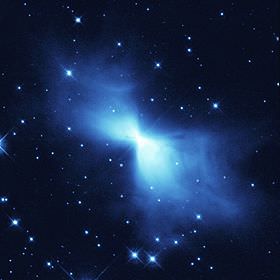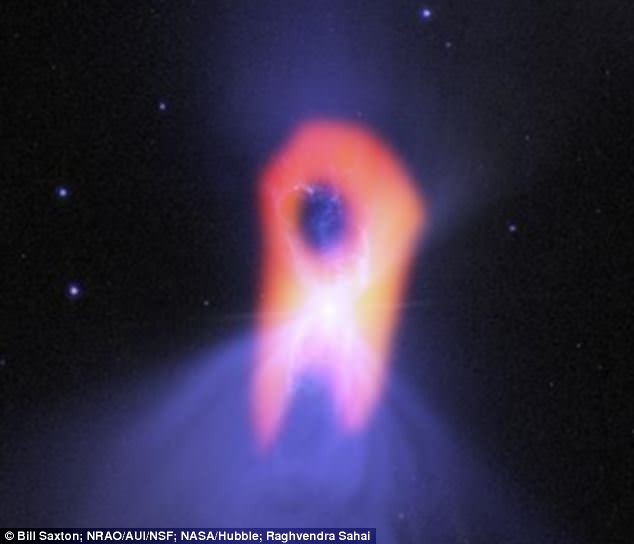Where is the coldest place in the Universe? Right now, astronomers consider the “Boomerang Nebula” to have the honors. Located about 5,000 light-years away in the constellation Centaurus, this pre-planetary nebula carries a temperature of about one Kelvin – or a brisk, minus 458 degrees Fahrenheit. That makes it even colder than the natural background temperature of space! What makes it more frigid than the elusive afterglow of the Big Bang? Astronomers are employing the powers of the Atacama Large Millimeter/submillimeter Array (ALMA) telescope to tell us more about its chilly properties and unusual shape.
The “Boomerang” is different all the way around. It is not yet a planetary nebula. The fueling light source – the central star – just isn’t hot enough yet to emit the massive amounts of ultra-violet radiation which lights up the structure. Right now it is illuminated by starlight shining off its surrounding dust grains. When it was first observed in optical light by our terrestrial telescopes, the nebula appeared to be shifted to one side and that’s how it got its fanciful name. Subsequent observations with the Hubble Space Telescope revealed an hour-glass structure. Now, enter ALMA. With these new observations, we can see the Hubble images only show part of what’s happening and the dual lobes seen in the older data were probably only a “trick of the light” as presented by optical wavelengths.
“This ultra-cold object is extremely intriguing and we’re learning much more about its true nature with ALMA,” said Raghvendra Sahai, a researcher and principal scientist at NASA’s Jet Propulsion Laboratory in Pasadena, California, and lead author of a paper published in the Astrophysical Journal. “What seemed like a double lobe, or ‘boomerang’ shape, from Earth-based optical telescopes, is actually a much broader structure that is expanding rapidly into space.”
So what is going on out there that makes the Boomerang such a cool customer? It’s the outflow, baby. The central star is expanding at a frenzied pace and it is lowering its own temperature in the process. A prime example of this is an air conditioner. It uses expanding gas to create a colder core and as the breeze blows over it – or in this case, the expanding shell – the environment around it is cooled. Astronomers were able to determine just how cool the gas in the nebula is by noting how it absorbed the constant of the cosmic microwave background radiation: a perfect 2.8 degrees Kelvin (minus 455 degrees Fahrenheit).

However, the single-dish millimeter wavelength telescopes didn’t see things the same as Hubble. Rather than a skinny waist, they found a fuller figure – a “nearly spherical outflow of material”. According to the news release, ALMA’s unprecedented resolution permitted researchers to determine why there was such a difference in overall appearance. The dual-lobe structure was evident when they focused on the distribution of carbon monoxide molecules as seen at millimeter wavelengths, but only toward the inside of the nebula. The outside was a different story, though. ALMA revealed a stretched, cold gas cloud that was relatively rounded. What’s more, the researchers also pinpointed a thick corridor of millimeter-sized dust grains enveloping the progenitor star – the reason the outer cloud took on the appearance of a bowtie in visible light! These dust grains shielded a portion of the star’s light, allowing just a glimpse in optical wavelengths coming from opposite ends of the cloud.
“This is important for the understanding of how stars die and become planetary nebulae,” said Sahai. “Using ALMA, we were quite literally and figuratively able to shed new light on the death throes of a Sun-like star.”
There’s even more to these new findings. Even though the perimeter of the nebula is beginning to warm up, it’s still just a bit colder than the cosmic microwave background. What could be responsible? Just ask Einstein. He called it the “photoelectric effect”.
Original Story Source: NRAO News Release.


! degree Kelvin? One Kelvin surely?
A preprint of “ALMA Observations of the Coldest Place in the Universe: The Boomerang Nebula” is available here: http://arxiv.org/abs/1308.4360
looks more like a molar tooth
I like this report… ALMA has only just begun to ‘come on line’ and anything you can do to report what they are up to is appreciated! It’s just like using your eyes after being blind your whole life… Looks like the molar my dentist removed?
Thank you for allowing Disqus again! I detest google+
“Boomerang Nebula” to have the honors. Located about 5,000 light-years away in the constellation Centaurus,
I have calculated the distance of this coldest star as Pi^2 x Avo. No.x root of 2 / R = 4874.220496 light years. (R = Ratio of atom and electron). This length is to be accurate distance of “Boomerang Nebula”. The finding of formula written in the book Complete Unified Theory (1998). I have find the distances of stars, planets, quasars, galaxies, planets of solar system almost correctly and written in my book.
Thanks to all scientists those who were discovered this star.
Nirmalendu Das
Dated:
31-10-2013.
Read more: http://www.universetoday.com/105774/alma-warms-up-the-view-of-the-coldest-place-in-the-universe/#ixzz2jIjOptfR